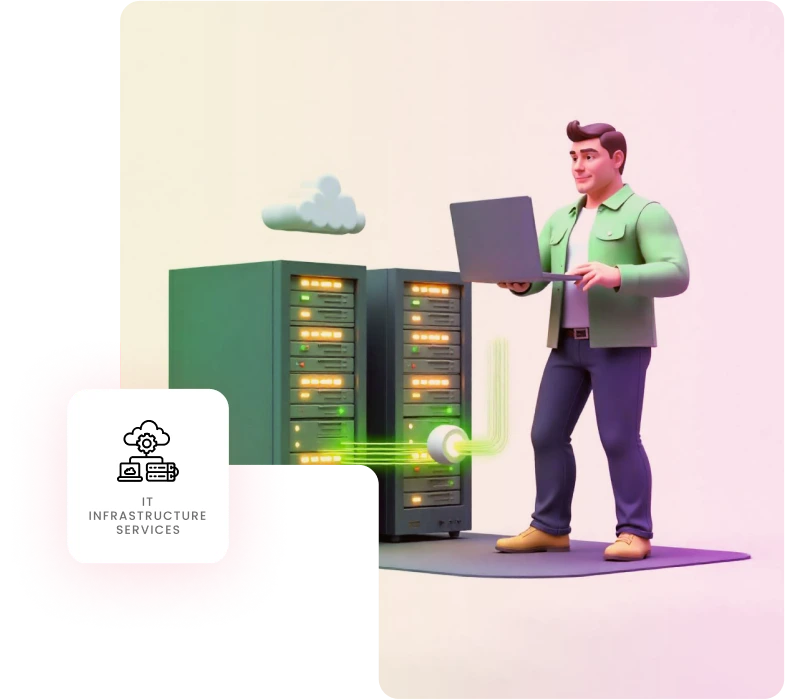IT Infrastructure Management Services for Modern Enterprise Demands
Guarantee agility, performance, and uptime with IT infrastructure management services designed to support your hybrid workloads, distributed teams, and critical IT operations.
Partnered by 150+ technology-led enterprises across industries

Run Lean, Secure, and Scalable with Smarter Infrastructure
niche player in the 2024 Gartner® Magic Quadrant™ for f&a
Modern businesses rely on resilient, flexible, and secure infrastructure to keep operations running without friction. With the rise of remote workforces, cloud-native applications, and interconnected systems, IT infrastructure is no longer just a backend function; it’s the foundation for business continuity and innovation.
Our IT infrastructure management services provide always-on support, cloud integration, system optimization, and proactive issue prevention. Whether you need remote infrastructure management, managed OS services, or 24x7 monitoring, we help reduce risks, lower operational costs, and enable seamless scalability across environments.
With deep expertise in both legacy and modern platforms, we align your infrastructure strategy with business priorities to ensure agility, visibility, and long-term value.
Our Core IT Infrastructure Services
Managed OS Services
Operating system support across Linux, Windows, and Unix platforms, including updates, security hardening, and lifecycle management.
Managed Database Services
Performance tuning, replication setup, backup, and scaling across SQL, Oracle, PostgreSQL, and NoSQL databases.
Remote Infrastructure Management
Centralized control and real-time support across servers, storage, and network devices with performance insights and rapid issue resolution.
Cloud Infrastructure Management Services
Proactive management of multi-cloud environments (AWS, Azure, GCP), including workload balancing, patching, and access controls.
IT Infrastructure Monitoring Services
24x7 system health tracking, predictive alerting, root-cause analysis, and SLA-based issue escalation.
Network Operations Center (NOC) Support
Round-the-clock visibility, traffic optimization, intrusion detection, and encrypted traffic inspection.
ITSM Integration Services
Seamless alignment with your ITSM tools for unified ticketing, reporting, and change management workflows.
Infrastructure Compliance & Audit Support
Ensure audit readiness, policy alignment, and reporting across HIPAA, SOC2, ISO 27001, and internal standards.
Our Approach to
IT Infrastructure Management

Assess & Align
Evaluate your existing infrastructure stack, dependencies, risks, and performance KPIs.

Monitor & Maintain
Implement real-time monitoring tools, patching schedules, and system health dashboards.

Optimize & Automate
Leverage infrastructure automation, predictive analytics, and resource allocation models to reduce overhead.

Protect & Scale
Secure endpoints, implement data backup strategies, and scale workloads with zero business disruption.

Report & Improve
Deliver actionable insights, SLA compliance reports, and continuous service improvements.
Why IT Infrastructure Management Services Matter
Reduced Downtime
Prevent failures before they occur with proactive alerts and automated remediation.
Increased Efficiency
Optimize workloads and resource consumption across dynamic business demands.
Scalable IT Models
Deploy infrastructure that grows with your operations—on-prem, cloud, or hybrid.
Regulatory Compliance
Ensure consistent alignment with industry and internal security frameworks.
24x7 Expert Coverage
Global support teams available around the clock for instant resolution.
What Makes Our Infrastructure Model Work
- Enterprise-grade IT infrastructure support that’s scalable and secure
- Unified monitoring and support across endpoints, servers, and cloud platforms
- 24x7 remote infrastructure management with certified experts
- Predictable pricing and dedicated support models
- Fully integrated with your ITSM ecosystem and DevOps pipelines
Case Studies
Infrastructure without Interruption
See how enterprises improved infrastructure reliability, reduced IT incident rates by 40%, and enabled 24/7 operations through managed IT infrastructure services.
View all Case StudiesFAQs
IT Infrastructure Management
These services cover end-to-end IT operations support, including server management, network operations, cloud administration, database tuning, system patching, and performance monitoring.
We deploy intelligent monitoring tools that provide 24/7 observability across servers, network devices, cloud assets, and applications. These tools use thresholds, predictive analytics, and anomaly detection to trigger real-time alerts. Our support teams respond through predefined workflows to mitigate risks proactively, ensuring minimal service disruption.
We support AWS, Microsoft Azure, Google Cloud, and private cloud environments, including hybrid setups with workload optimization and governance tools.
We enforce a layered security model combining identity and access management (IAM), endpoint detection and response (EDR), network segmentation, and data encryption. Continuous vulnerability scanning and compliance monitoring are embedded into workflows to mitigate evolving threats.
Yes. Our global team provides round-the-clock monitoring and support services with strict SLAs and tiered response protocols.
Absolutely. Our services are designed to scale seamlessly with your evolving needs. Whether you’re expanding globally, migrating to the cloud, or integrating new workloads, we offer flexible engagement models—dedicated, shared, or hybrid—that adapt to your business growth, seasonal demand spikes, or M&A transitions.
Yes. We integrate with leading ITSM platforms such as ServiceNow, BMC Remedy, and Freshservice. This guarantees unified workflows for incident management, change control, asset tracking, and service reporting.
Yes. We offer 24x7 remote infrastructure support across the US, including major tech hubs like Chicago, Sugar Land (TX), and Detroit. Our services are delivered through global delivery centers backed by local expertise.
Trying to Stabilize and Scale Your IT Core?
We answer common questions on infra monitoring, patch cycles, and hybrid IT operations.
IT Infrastructure knowledge base


